In photos: Colonial India through the eyes of foreign artists

 DAG
DAG
A new exhibition in Delhi showcasing rare artworks by European artists gives insights into how the British ruled the country.
Called Destination India: Foreign Artists in India, 1857-1947, the show focuses on artists who travelled to colonial India from around the world.
The representation of India through the European and British artists has “long been a subject of intrigue and exploration”, writes Indian MP and author Shashi Tharoor, in an introduction to the show.
“The fascination with India’s unique landscapes, grand monuments, vibrant traditions and rich history has drawn many to its shores, seeking to capture the essence of this multifaceted nation.”
Mr Tharoor notes that the show is “refreshing and essential” as it explores the less-explored, yet a compelling period of the late 19th and early 20th centuries, rather than just the early pioneers.
The exhibition showcases artworks, including from British artist William Carpenter, that give glimpses into not only the royal courts, but also daily life in the Empire.

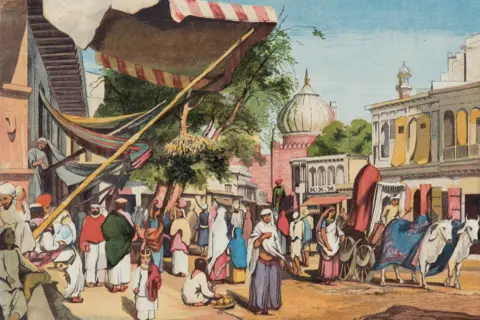 DAG
DAG
Carpenter usually did watercolour, but this 1857 artwork, pictured above, is wood engraving on paper that depicts the busy back streets of Delhi’s Jama Masjid (mosque).
Many interesting artists visited India from England and other European countries in the late 19th and early 20th centuries. They were mainly conventional artists working in oil and watercolour and various print media.
“They were attracted to the people, and not just to the grandees, but to ordinary people in the streets. If there was still an element of the picturesque, it was a more intimate and animated version of that aesthetic,” says Ashish Anand, managing director of DAG, a leading art firm which has put together the show.
“In their works we find an India – if we can put it this way – that we do not just see, but that we can hear and smell.”

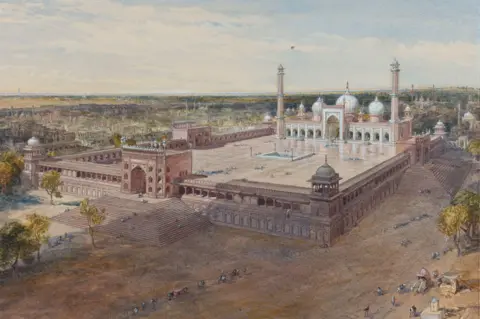 DAG
DAG
The work above is another watercolour painting of the Jama Masjid by William Simpson in 1864.
Mainly a war artist, Simpson was sent to India in 1859 by a publishing company to illustrate the aftermath of the violent uprising two years earlier. Indian soldiers, known as sepoys, had in 1857 set off a rebellion against the British rule, often referred to as the first war of independence.
Simpson’s project halted when the publishing company went bankrupt. He called it the “biggest disaster of my life”. Nonetheless, he continued travelling and sketching his expeditions across the sub-continent.

 DAG
DAG
This is a 1900 pastel portrait of elderly Indians by Olinto Ghilardi, an Italian artist.
A significant European artist, Ghilardi shaped modern Indian art in the early 20th Century.
He mentored Abanindranath Tagore – nephew of Nobel laureate Rabindranath Tagore and founder of the Bengal School of Art, which shaped modern Indian painting. Ghilardi encouraged him to experiment with watercolours, gouache, and pastels, which he extensively used later in his work.
Ghilardi also served as the vice principal of the Government School of Art in Calcutta (now Kolkata).

 DAG
DAG
This 1896 painting of a young Indian woman was also made by Ghilardi.
Not much is known about the life of the Italian painter before he arrived in Kolkata. His association with Tagore indicates his acceptance as an artist among Kolkata’s Bengali elite.
Much later, in 1911, Ghilardi became a prominent member of an avant-garde group of Italian artists.

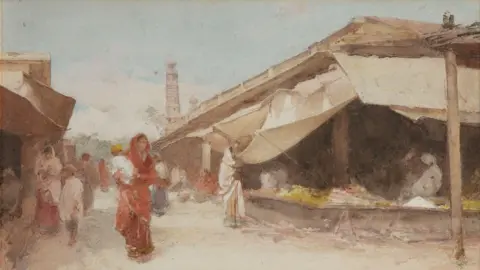 DAG
DAG
This is British artist Carlton Alfred Smith’s undated watercolour painting of a street scene in India.
Smith lived in India between 1916 and 1923. He often painted landscapes along with portraits of people.
A painter of the late Victorian period from Camden Town in London, Smith began as a lithographer before switching to painting. A member of the Royal Academy of Art, he’s known for drawing interiors of cottages and the English countryside.

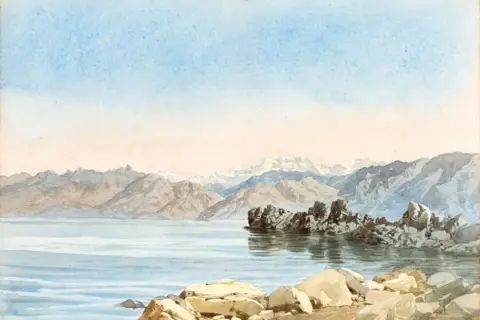 DAG
DAG
This is a 1894 watercolour painting of Kashmir’s Wular Lake by George Strahan, a British army engineer and artist.
A gifted student from Surrey, Strahan joined the army and arrived in India in 1860, working in towns of Roorkee and Haridwar.
Two years later, he joined the Topographical Survey of India and started mapping central India, Rajasthan and the Himalayas.
In 1888, he became superintendent of the Great Trigonometrical Survey, which mapped the Indian subcontinent.
At the Survey, Strahan drew relief maps before colour printing was introduced.
After retirement, he lived in the hills of Dehradun and travelled to Kashmir every summer.

 DAG
DAG
This is an 1887 watercolour of Hyderabad in southern India by German artist Woldemar Friedrich.
A historical painter and illustrator, Friedrich spent much of his career teaching at prestigious German art academies. In the late 1880s, he travelled to India and created a series of landscapes and illustrations, published in the 1893 book “Six Months in India”.

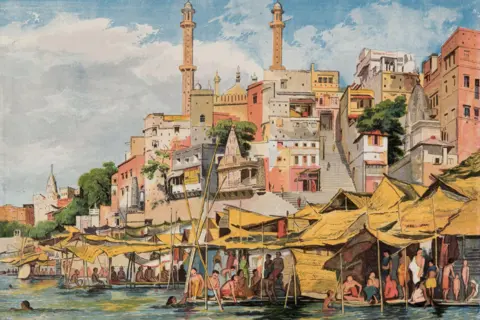 DAG
DAG
Carpenter’s 1857 wood engraving on paper artwork on Benaras (above) shows Varanasi – one of the world’s oldest cities and and India’s spiritual capital – brimming with life.
Trained at the Royal Academy Schools in London, Carpenter became a renowned 19th-Century portrait and landscape painter.
Arriving in India in 1850, he travelled extensively, painting rulers, street scenes, landscapes, and locals across Bombay (now Mumbai), Rajasthan, Delhi, Punjab, Kashmir, Lahore, Ceylon (Sri Lanka), and Afghanistan.

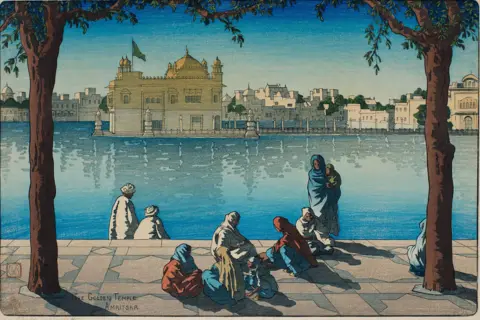 DAG
DAG
This is English artist Charles William Bartlett’s 1919 woodblock print on paper rendition of Punjab’s Golden Temple, a sacred shrine for Sikhs.
Dover-born Bartlett was one of the world’s leading Japanese woodblock painters, and later switched to fine art.
In 1913, he travelled to India, Indonesia and China. He designed 38 woodblock prints for his Japanese publisher from 1916 to 1925, including many scenes from his travels in South Asia.

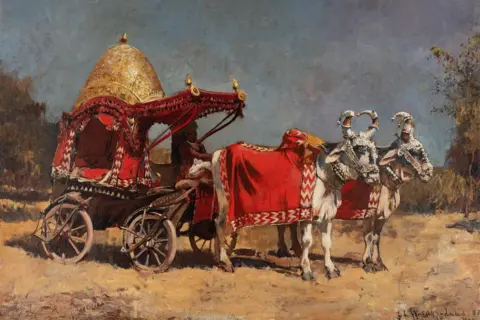 DAG
DAG
American artist Edwin Lord Weeks painted this colourful oil on canvas of a bullock-cart in Ahmedabad, Gujarat, in 1882.
Born in Boston to a wealthy family, Weeks was among the first American artists to visit India. His business family supported his artistic endeavours.
Weeks first travelled to India between 1882 and 1883, painting places mainly in Rajasthan. He returned in 1886, when he visited at least seven cities. Known for his realist style and attention to detail, Weeks also wrote a travel account of his journeys through Persia (present day Iran) and India in 1896.
